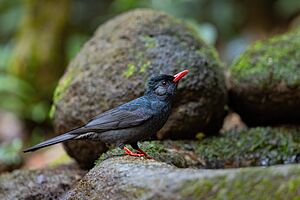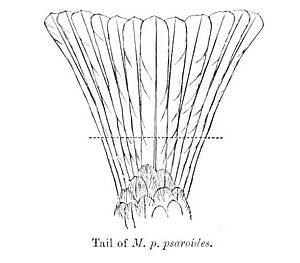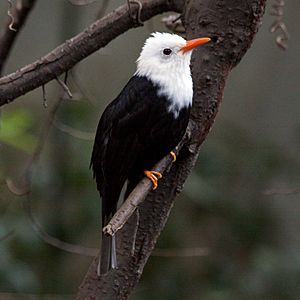Black bulbul facts for kids
Quick facts for kids Black bulbul |
|
|---|---|
 |
|
| Conservation status | |
| Scientific classification | |
| Synonyms | |
|
The black bulbul (Hypsipetes leucocephalus) is a type of bird that belongs to the bulbul family. You might also hear it called the Himalayan black bulbul or Asian black bulbul. These birds mostly live in the Himalayas, stretching from Pakistan all the way to Southeast Asia.
Black bulbuls are known for their rich orange-red legs and beak. Their body feathers can be different shades, from grey to black. Some even have white heads, which is why their scientific name leucocephalus means "white head"!
Contents
About the Black Bulbul's Name
The black bulbul got its official name in 1789 from a German scientist named Johann Friedrich Gmelin. He first put it in the same group as thrushes. He gave it the scientific name Turdus leucocephalus.
Gmelin learned about this bird from a description of a white-headed bulbul from China. The name leucocephalus comes from ancient Greek words meaning "white-headed."
Later, in 1831, another scientist named Nicholas Aylward Vigors created a new group, or genus, for these birds called Hypsipetes. This name means "high-flyer" in ancient Greek. The black bulbul is now one of 19 species in this group.
Different Types of Black Bulbuls
Scientists recognize ten different types, or subspecies, of the black bulbul. These types often look a bit different or live in different areas. For example, some have white heads, while others are mostly dark.
Here are a few examples of these subspecies:
- H. l. psaroides: Found along the Himalayas.
- Assam black bulbul (H. l. nigrescens): Lives in parts of India and Myanmar.
- Burmese black bulbul (H. l. concolor): Found in eastern Myanmar and parts of China.
- H. l. stresemanni: These birds have white heads and live in central China.
- H. l. leucocephalus: This is the original white-headed type, found in southeastern China.
- H. l. nigerrimus: Found in Taiwan.
What Does a Black Bulbul Look Like?
Black bulbuls are about 24 to 25 centimeters (about 9 to 10 inches) long. They have a long tail. Their body feathers can be dark grey or shiny black. Their beak, legs, and feet are a bright orange color. They also have a fluffy black crest on their head.
Male and female black bulbuls look very similar to our eyes. However, young birds look a bit different. They don't have the crest, and their belly is whitish with a grey band on their chest. Their upper feathers are brownish.
What Sounds Do They Make?
Black bulbuls can be quite noisy birds! They make many different loud sounds. These include cheeping, mewing, and grating calls. Some people say the calls of the Himalayan black bulbul sound a bit like a baby goat!
Where Do Black Bulbuls Live?
You can find black bulbuls in forests with broad-leaved trees. They also live in gardens and farm areas, especially in hilly regions. In winter, some populations from the Himalayas might fly down to the flat plains.
How Do They Raise Their Young?
Black bulbuls build their nests in trees or bushes. Their nest is shaped like a cup and is often placed in a fork of branches. They make their nests from things like grasses, dry leaves, moss, and spiderwebs. The inside is soft, with ferns and small roots. Both the male and female birds help build the nest. They usually lay two or three eggs at a time.
What Do Black Bulbuls Eat?
Black bulbuls mainly eat seeds and insects. You can often see them in small groups, either resting or flying around looking for food. They really love berries! They eat many kinds of berries, including those from Celtis, Rosa, and Melia plants in the Himalayas. They also drink nectar from flowers like Salmalia and Rhododendron. Sometimes, they fly out to catch insects in the air.




